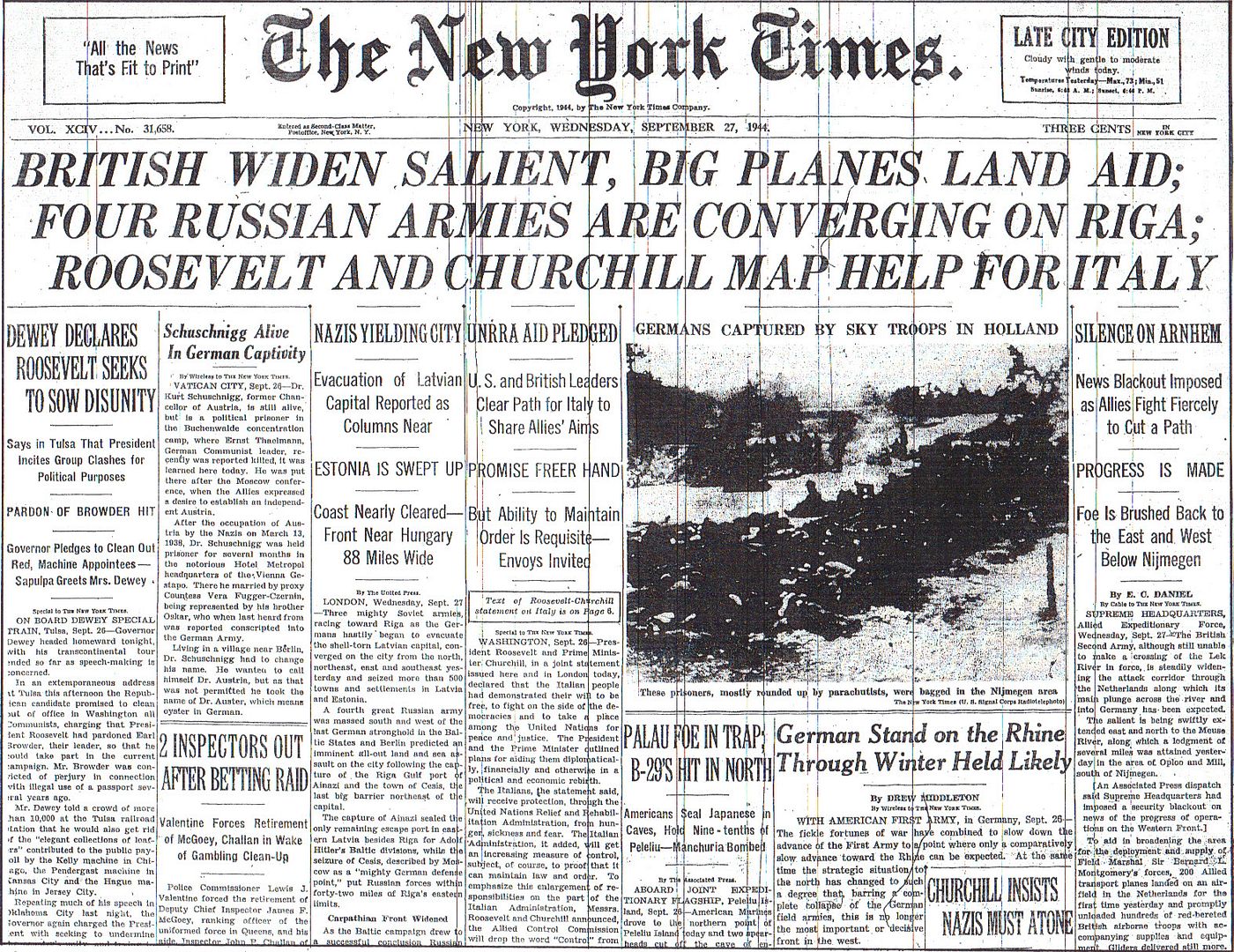
Posted on 09/27/2014 5:41:29 AM PDT by Homer_J_Simpson

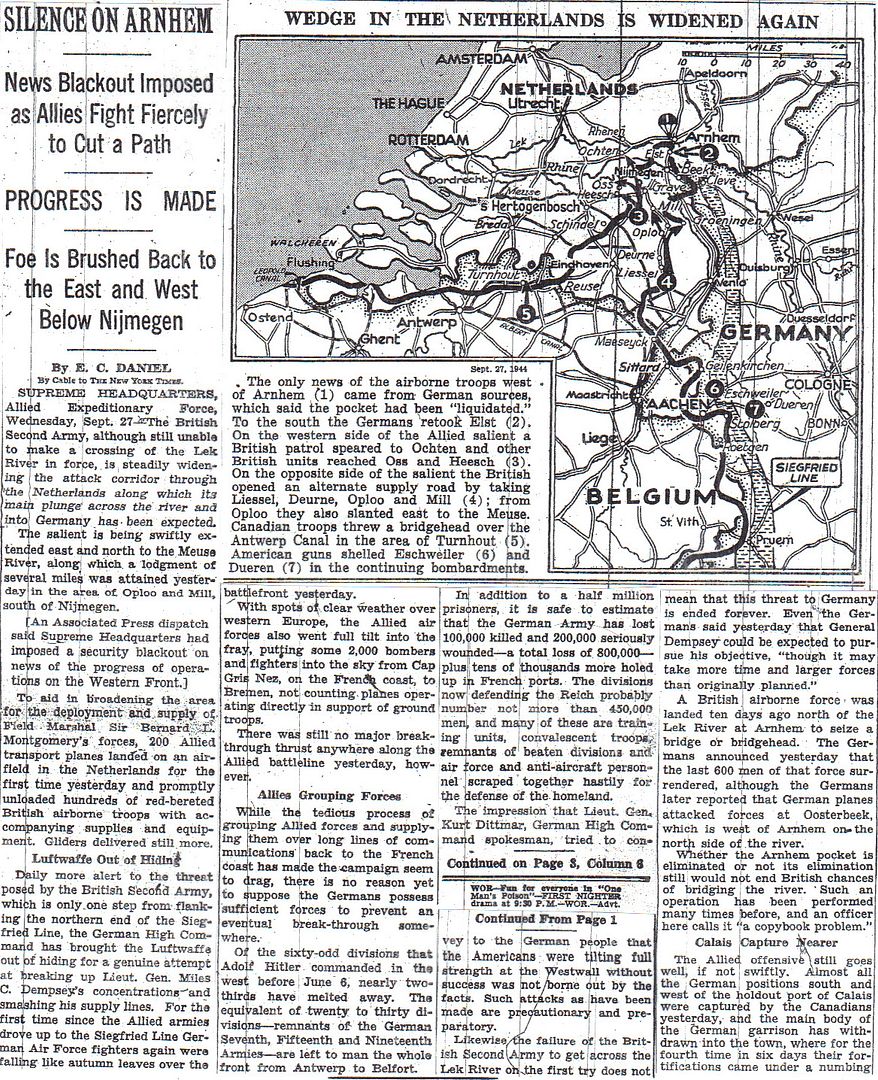
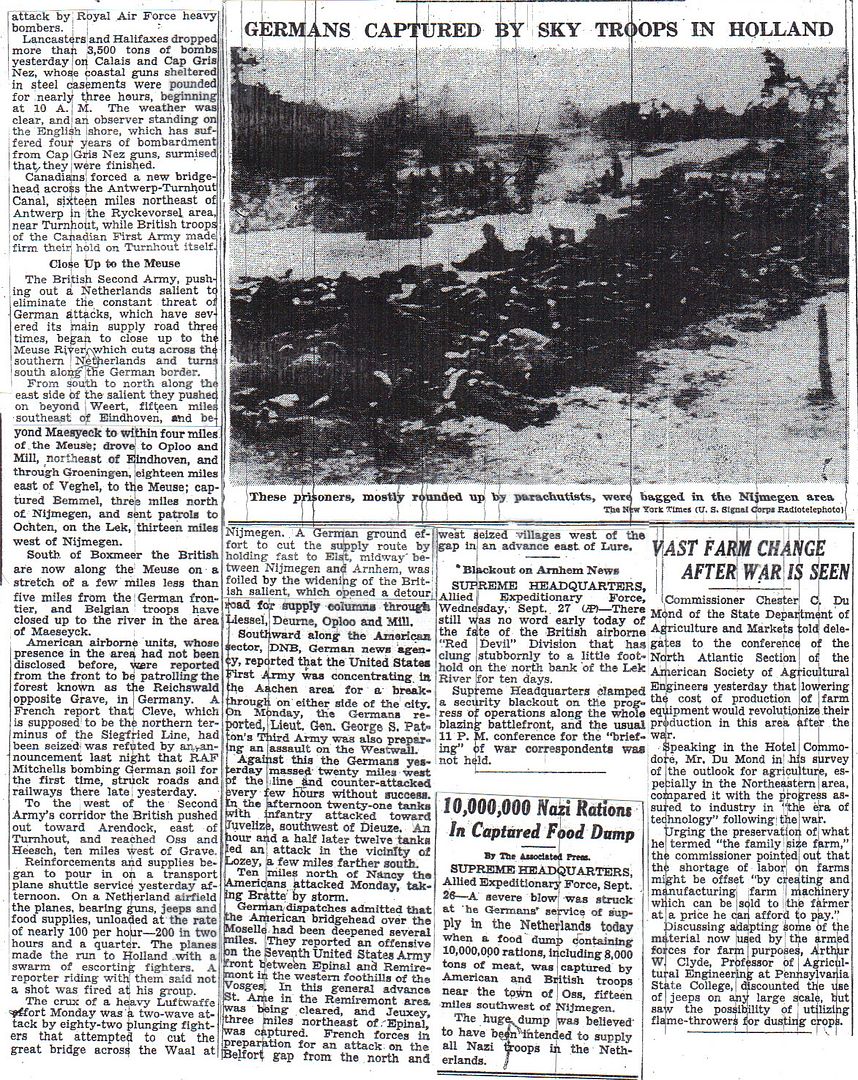
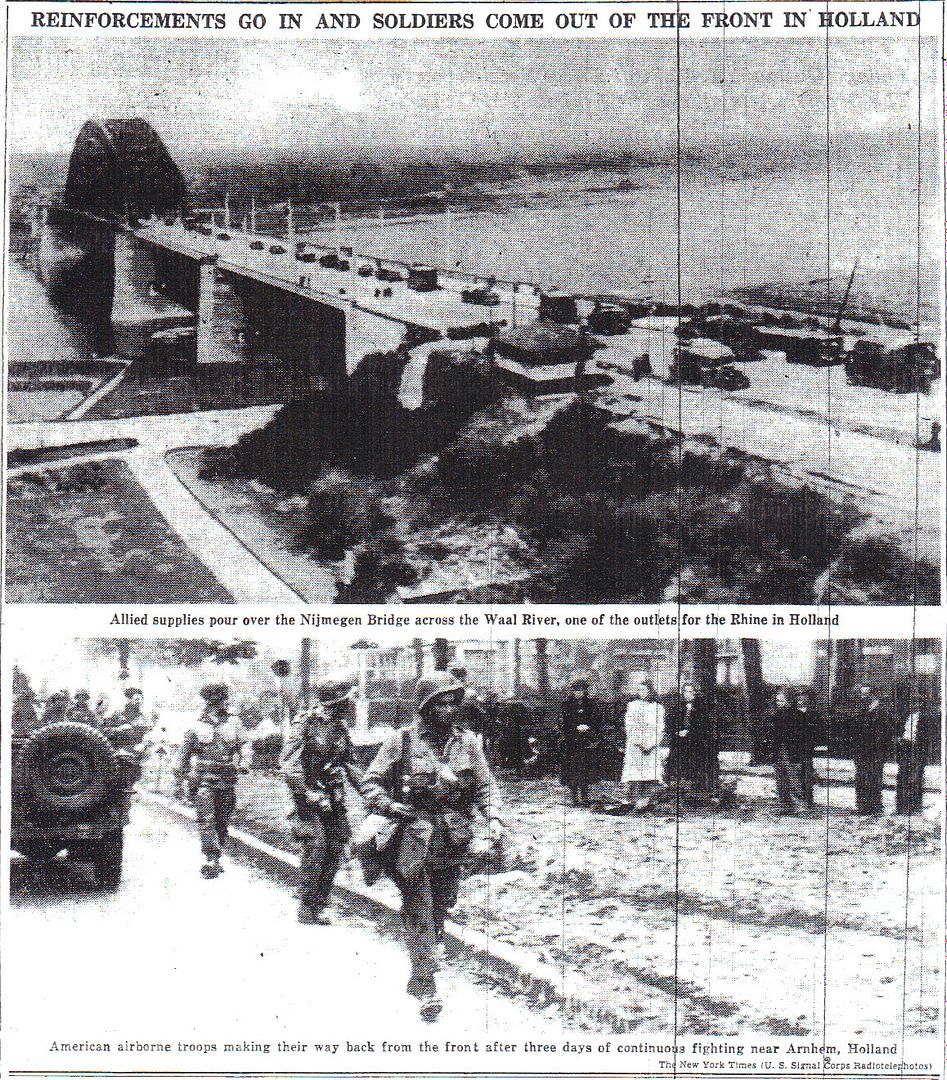
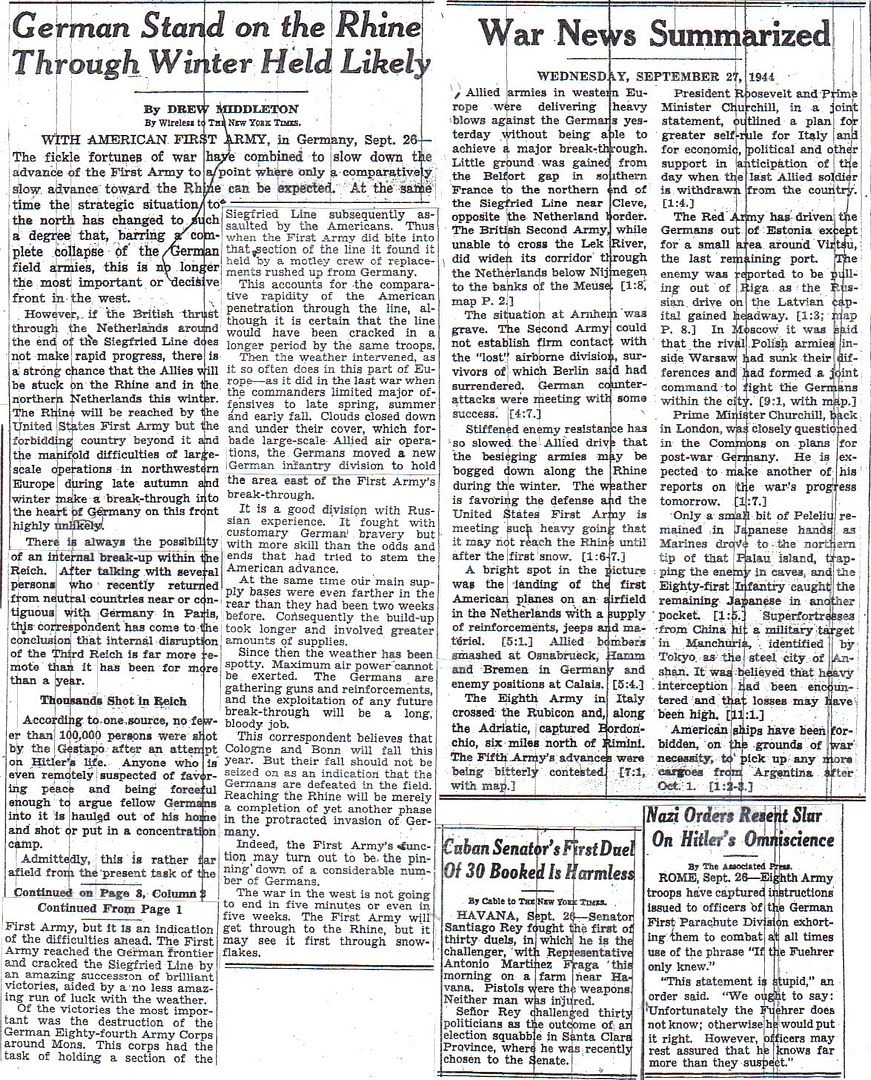

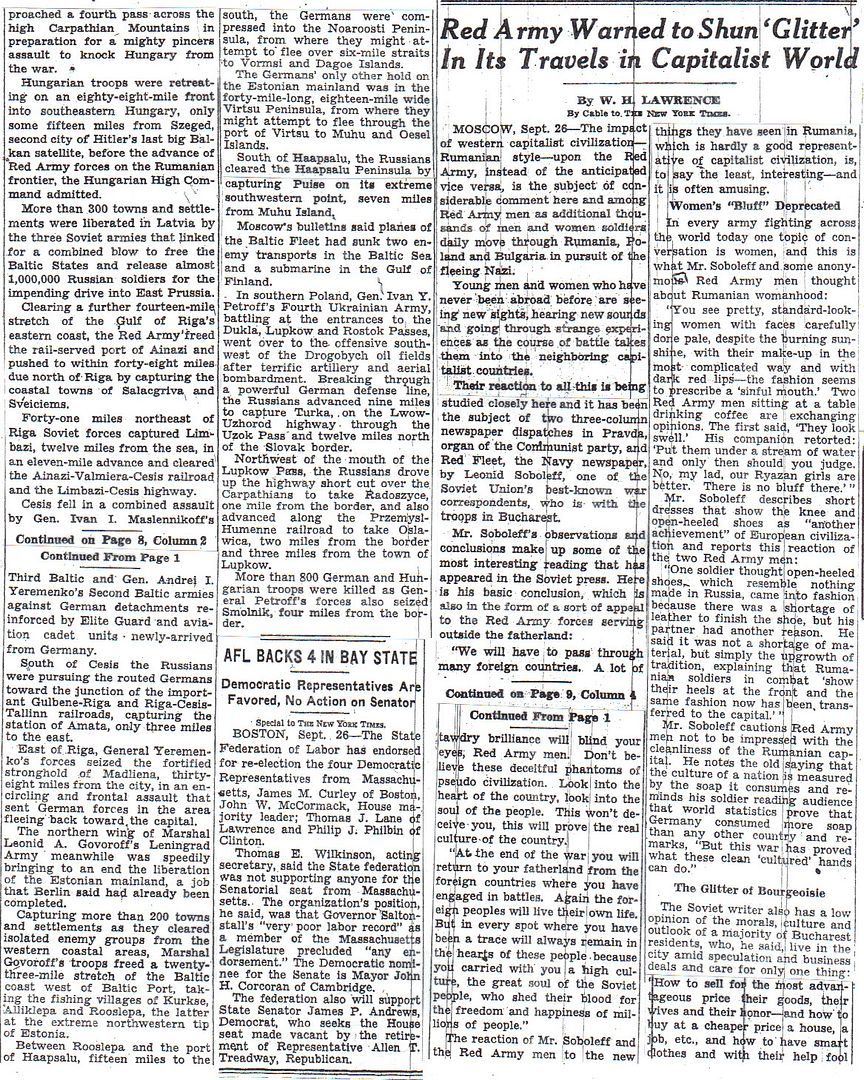

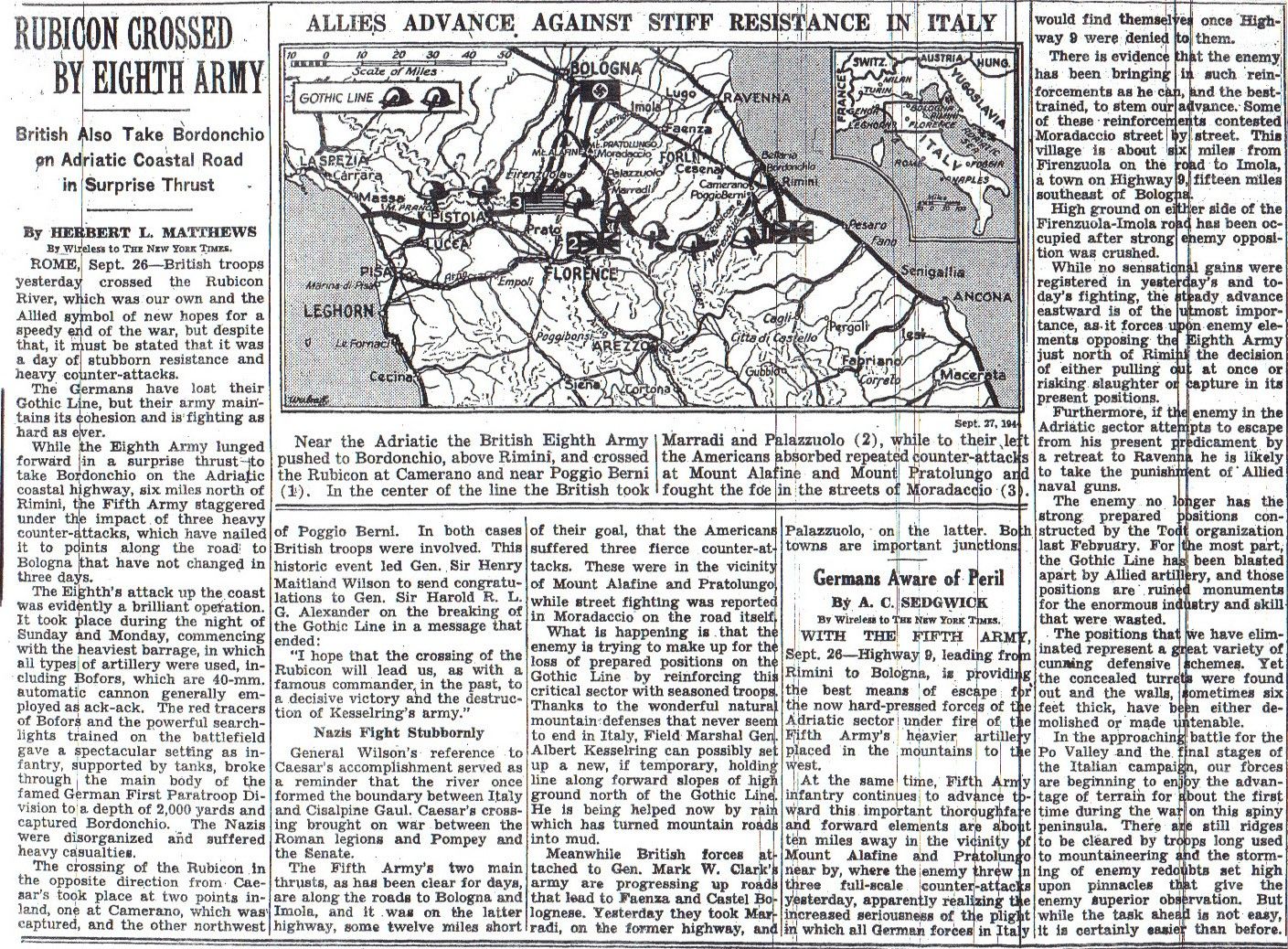
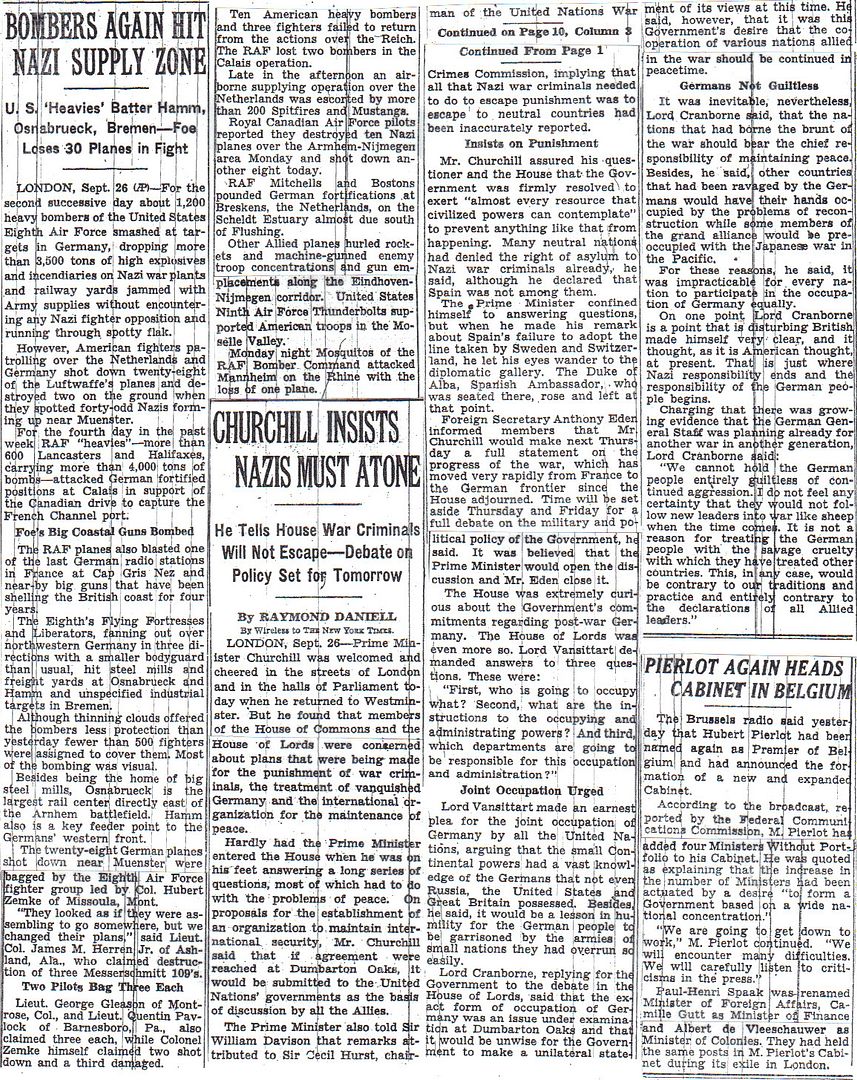
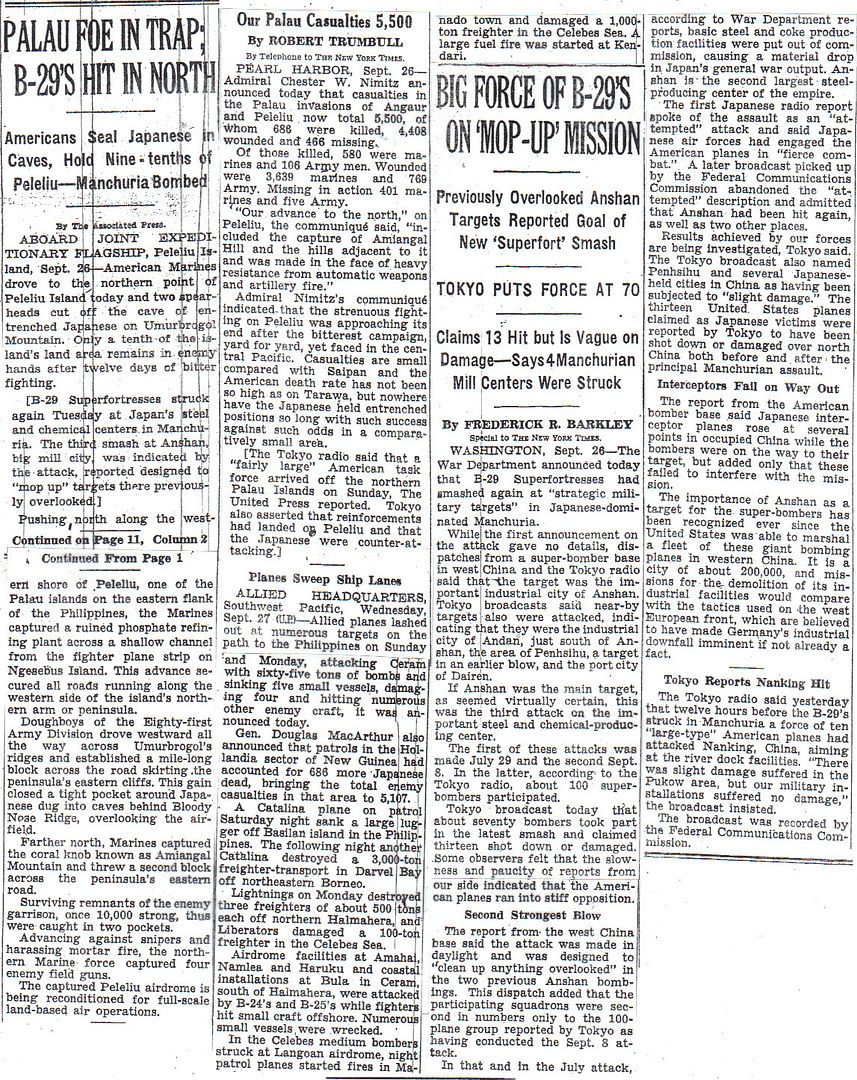
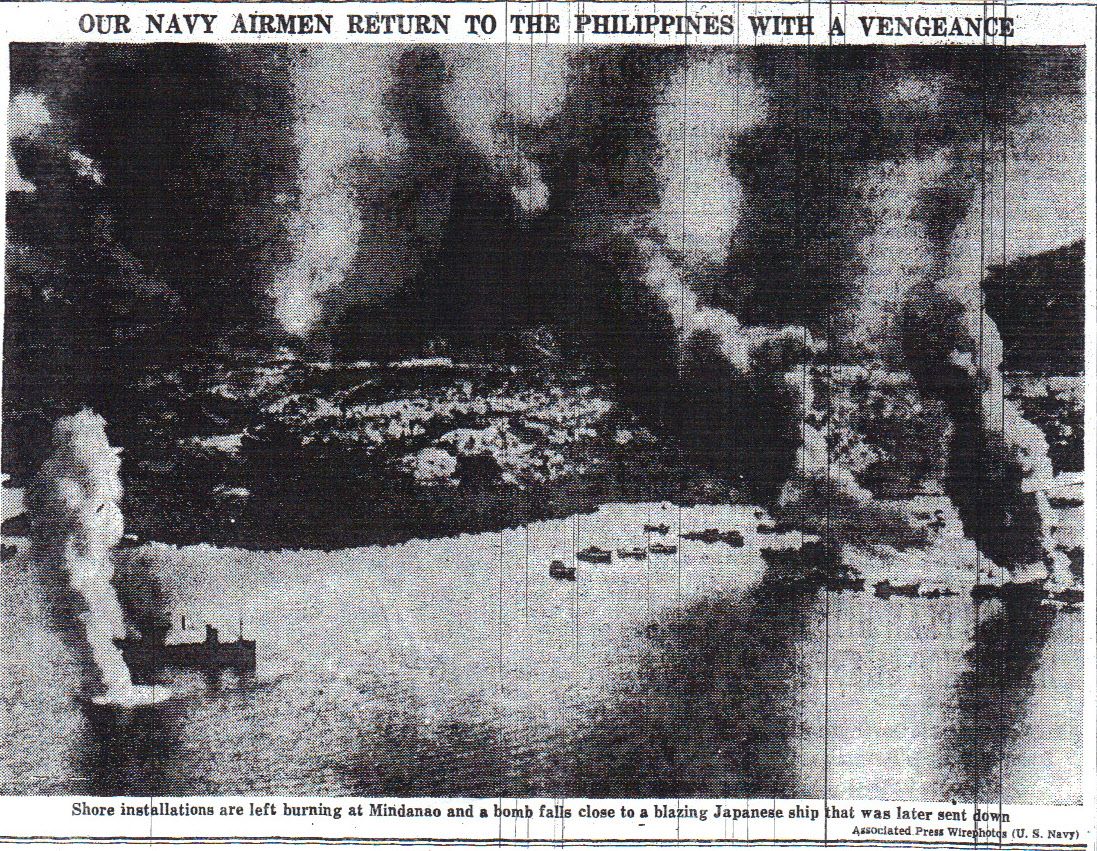

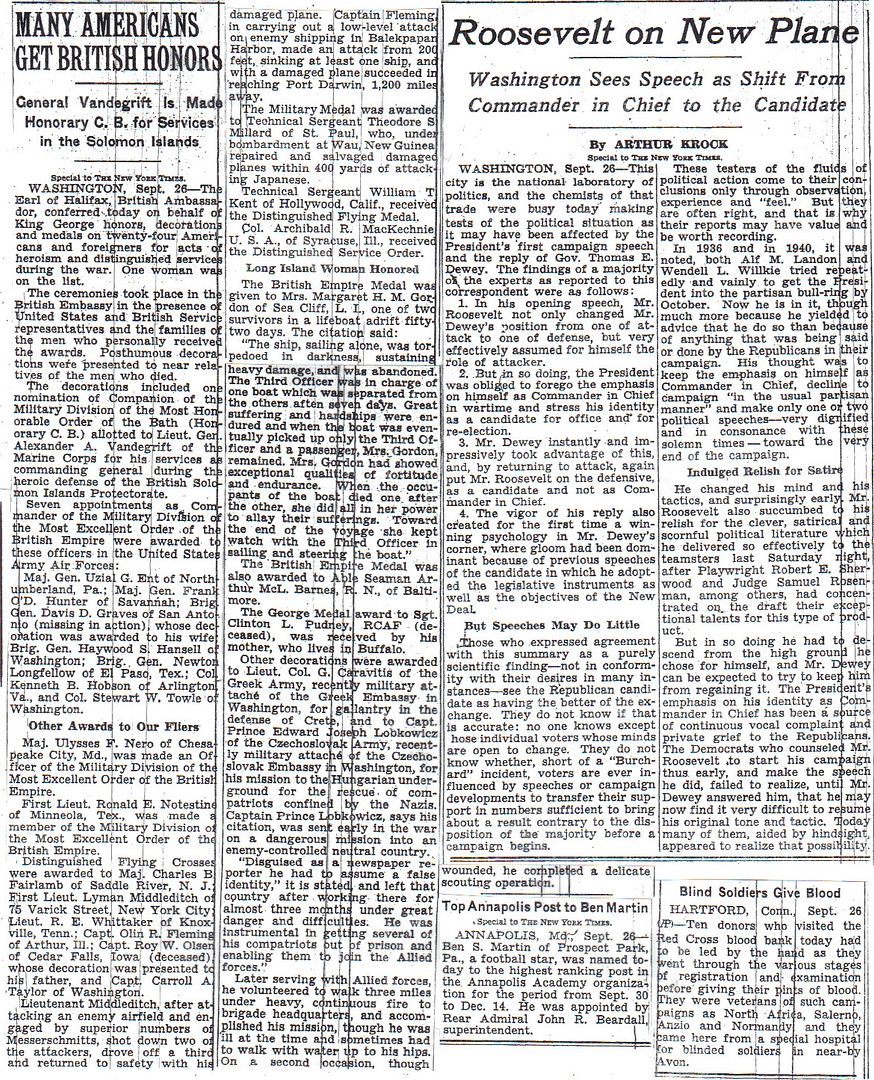

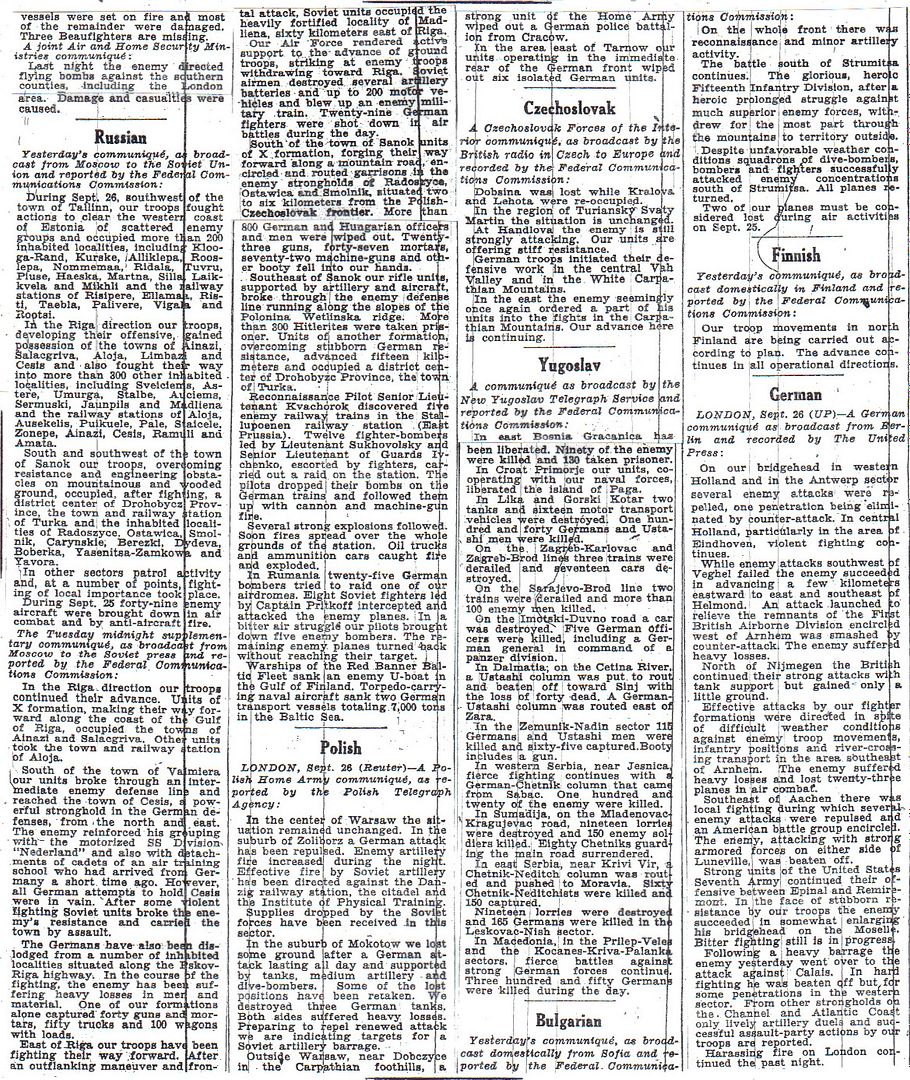
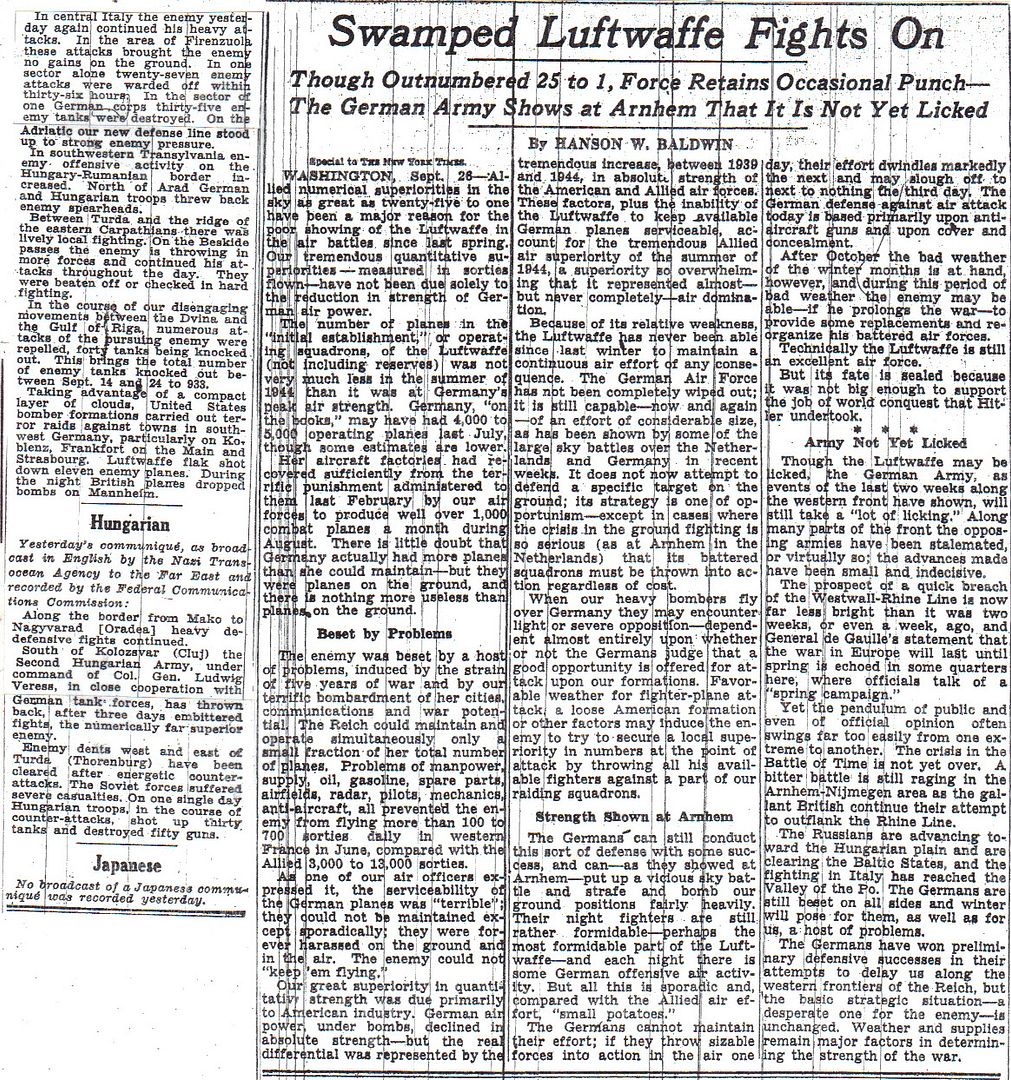
* Headline writer happy.
http://www.onwar.com/chrono/1944/sep44/27sep44.htm#
Americans attacking Metz
Wednesday, September 27, 1944 www.onwar.com
A breach view of 2 destroyed US tanks before Metz [photo at link]
On the Western Front... The US 20th Corps (part of US 3rd Army) begins attacks on the outer defenses of the fortress town of Metz. Meanwhile, the British 2nd Army achieves limited advances south of Arnhem in the Netherlands.
Over Germany... British bombers target railway marshalling yards east of the Rhine River.
On the Eastern Front... In Estonia, Soviet forces have eliminated most German resistance. The Soviet 2nd and 3rd Belorussian Fronts make an unsuccessful attempt to storm the German Sigulda Line, north of Riga. Meanwhile, Soviet forces land on Vormsi Island, west of Haapsula. In Hungary, there is heavy fighting around Cluj as German forces counterattack.
In Sweden... Ports are closed to German shipping.
http://www.etherit.co.uk/month/8/27.htm
September 27th, 1944 (THURSDAY)
UNITED KINGDOM: Whilst serving as an aircraft target ship, destroyer HMS Rockingham is mined in the North Sea SE of Aberdeen and taken in tow, but sinks in 56 29N 00 57W. There are no casualties. (Alex Gordon)(108) While returning to Aberdeen, poor navigation brought her into the defensive minefields off the east coast of the United Kingdom, and after striking a mine Rockingham was abandoned and sank with the loss of one life. USS Swasey (DD-273), commissioned as HMS Rockingham (G-58) on 26 Nov. 1940, part of the destroyers-for-bases deal. (Ron Babuka)
STRATEGIC OPERATIONS: The US Eighth Air Force flies 2 missions.
Mission 650: 1,192 bombers and 678 fighters, in 3 forces, are dispatched to hit industrial and transportation targets in western Germany and use PFF methods for all targets; 28 bombers and 2 fighters are lost.
(1) 421 B-17s hit a secondary target (Cologne) and 10 others hit Blatzheim; escort is provided by 221 P-47s and P-51s; they claim 5-0-0 aircraft in the air.
(2) B-17s bomb Ludwigshafen/Opau oil refinery (214) and Mainz (171); 4 others hit targets of opportunity; 2 B-17s are lost; escort is provided by 212 P-47s and P-51s; they claim 1-0-0 aircraft in the air.
(3) B-24s attack Kassel/Henschel aircraft plant (248); 35 also hit Gottingen; they claim 5-3-0 aircraft; 26 B-24s are lost; escort is provided by 207 P-38s, P-47s and P-51s; they claim 25-0-6 aircraft in the air and 5-0-1 on the ground; 2 P-51s are lost.
- Mission 651: 8 B-17s drop leaflets in France, the Netherlands and Germany during the night.
- 163 B-24s on a TRUCKIN’ mission carry fuel to France.
TACTICAL OPERATIONS: US Ninth Air Force fighters fly armed reconnaissance, cover US First and Third Army forces in western Germany and eastern France and later fly night patrols in Belgium, Luxembourg, and western German areas. In France, nearly 300 B-26s and A-20s abort missions due to weather; 8 manage to bomb a target at Foret de Parroy.
NETHERLANDS: Arnhem: The last British and Polish troops trapped at Arnhem surrendered to the Germans yesterday after holding the bridgehead against overwhelming odds for nine days. For the last three days many of the men were without water and survived on rations cut to one-sixth. During heavy rainstorms they gathered water in their capes. When at last the men were ready to leave, they stood with heads bowed while the padre said a prayer.
The order to abandon the operation was given by Montgomery on Monday, and the withdrawal south across the Rhine took place during the night of 25-26. Only 2,400 men out of more than 10,000 who took part in the operation got away in boats or by swimming across; 1,200 were killed and 6,642 have been taken prisoner. Allied HQ claims that 12,000 Germans were killed or wounded in the fighting.
Allied casualties could have been higher. Major Richard Lonsdale out together a rearguard force of men who had been separated from their units. With this force, he defended the bridgehead perimeter to allow others to escape. Then, despite his wounds, he swam across the mile-wide river to the safety of the south bank, where a battalion of the Dorsetshire Regiment had arrived, having overcome tenacious German resistance all the way from Nijmegen, ten miles distant.
Though the Allies failed to hold the Rhine crossing, Eisenhower reckons the operation was worthwhile; by securing the crossings of the Maas and the Waal it advanced the Allied front to Nijmegen and put the defence of Antwerp beyond doubt.
Arnhem: Every survivor has a tale to tell of terror by day and night under a hurricane of fire from the Germans, and the deeds of bravery and self-sacrifice are legion. “Give us a few tanks,” they say, “and we’ll go back and finish the job.”
“The Panzers were causing us a lot of trouble,” says Captain Bethune Taylor, from Cheltenham. “So a major went out with a Piat and took two on. Every time he put his head out the Panzers fired. But he set his Piat and bagged one.” Lance-Corporal John Stilwell, of Hackney Wick, came under attack from flame-throwers. “They got a man next to me. He screamed in agony. We made our way to the river. One man did wonders, keeping three Vickers going to keep the escape channel open.”
BELGIUM: British Field Marshal Bernard L. Montgomery, General Officer Commanding 21st Army Group, orders Canadian General Henry Crerar, General Office Commanding First Canadian Army, to clear the Schelde, the navigable river running through Antwerp, as quickly as possible.
During the day, 73 RAF Bomber Command Halifaxes fly petrol (gasoline) carrying flights from the U.K. to Melsbroek Airfield in Brussels.
NETHERLANDS: German aircraft make large-scale but futile efforts to destroy Nijmegen bridges.
FRANCE: The US XX Corps of the Third army begins attacks at Metz.
In U.S. Third Army’s XX. Corps area, the 5th Infantry Division begins limited attacks against Fort Driant, the outer bastion of Metz barring the northern approach to the city; after ineffective aerial bombardment at low level. In the XII Corps area, massed German tanks again attempt to drive in 4th Armored Division’s salient, making main effort on the southern flank where they succeed in taking Hill 318, southeast of Arracourt, which commands road to Nancy; subsidiary thrusts at Bezange-la-Petite and Xanrey are largely contained. The 35th Infantry Division, holding the Fort de Grmecey salient, undergoes sharp counterattacks. German columns push toward Grmecey and Pettoncourt from Chambrey, reaching the latter. When reinforcements from the 35th Infantry Division arrive, the Germans fall back toward Chambrey. Other German forces make limited penetration into the northeastern edge of the forest after infiltrating from Fort de ChateauSalins, but most of lost ground is recovered.
During the day, RAF Bomber Command dispathces 341 aircraft, 222 Lancasters, 84 Halifaxes and 35 Mosquitos, to attack positions in the Calais area; 323 aircraft bombed. The target areas are covered by cloud but the Master Bomber brought the force below this to bomb visually. The attacks on the various German positions are accurate and only one Lancaster is lost.
Allied HQ, FRANCE: The failure at Arnhem puts paid to hopes of ending the war this year, it also means that Montgomery has lost his battle for a single concentrated all-out drive into Germany. Eisenhower is back to his “broad front” strategy which the Americans have favoured all along.
Too many corners were cut at Arnhem. To save aircraft, the paras made three separate drops over three days, and the Germans never felt the British 1st Airborne Division at full strength. Radio equipment was inadequate and communications failed. Intelligence reports of panzer units at Arnhem were not believed. Then the paras landed too far from the bridges and some had an eight-mile march.
GERMANY: A female American flight nurse is among the five survivors of a C-47 Skytrain that is shot down by the Luftwaffe near Aachen. The Germans don’t know what to do with her but eventually send her to Stalag IXC where she works in the hospital. In February 1945 she is taken to Portuguese South Africa and placed on the Red Cross ship MS Grisholm for a prisoner exchange. She is later repatriated and eventually returns to duty at a stateside army hospital.
During the day, RAF Bomber Command sends 175 aircraft, 96 Halifaxes, 71 Lancasters and eight Mosquitos, to attack the Ruhroel AG synthetic-oil plant in the Welheim suburb of Bottrop; 134 bombed the target and 21 bombed the city. The target is almost entirely cloud-covered and most of the bombing is aimed at Oboe skymarkers, although a few aircraft are able to bomb through small breaks in the cloud. Explosions and black smoke are seen. No aircraft lost. In another mission, 171 aircraft, 143 Halifaxes, 21 Lancasters and seven 7 Mosquitos, attempted to bomb the Sterkrade oil plant; only 28 aircraft bombed the main target, through thick cloud; 49 aircraft bombed alternative targets, most of them aiming at the approximate position of Duisburg. No aircraft are lost.
During the night of 27/28 September, RAF Bomber Command sent 217 Lancasters and ten Mosquitos in the only major raid carried out by Bomber Command during the war on Kaiserslautern; 167 aircraft bombed the target and a Lancaster and a Mosquito are lost. Mosquito attacks during the night included 45 aircraft bombing Kassel, two bombed Aschaffenburg and two hitting Heilbronn.
U-2335 and U-2510 commissioned.
U-2333 laid down.
U-2516 and U-3509 launched.
FINLAND: The preliminary plan of starting an aggressive attack in Lapland was completed. Around that time, Siilasvuo decided of making an amphibious landing in Tornion, behind German lines.
The plan was opposed by many in the Finnish GHQ, but Siilasvuo answered that he took orders only from the Marshall himself, who didn’t intervene. (Sami Korhonen)
HUNGARY: Cluj is the scene of heavy fighting due to repeated German counterattacks.
ESTONIA: The organized German resistance on mainland Estonia is over. The Soviets land on Vormsi Island west of Haapsalu.
U.S.S.R.: Moscow: The Red Army is swiftly clearing Estonia of German troops as General Schorner conducts his skilful retreat through the Riga corridor to the comparative safety of Courland, the north-western part of Latvia where it bulges into the Baltic Sea. It remains to be seen how many men Schorner can get away as the Russians push through Latvia to seal off the corridor. With this manoeuvre the Russians are not only inflicting heavy casualties on the Germans but are also making sure that they will not be attacked from the rear when they open their inevitable assault on East Prussia.
YUGOSLAVIA: Dalmatia: British troops have joined Yugoslav partisans on the Dalmatian islands and are poised to invade the Yugoslav mainland.
Royal Navy coastal forces based on Vis, the outermost of the islands, are dominating coastal traffic. British commandos are also using Vis as a base to establish artillery positions on the island of Brac from which to attack German supply lines and prevent German patrol boats from putting to sea.
Fierce battles are also taking place in Albania to the south where the German garrison has been ordered to protect the single railway line bringing escaping troops from Greece.
ITALY: In U.S. Fifth Army’s IV Corps area, The South African 6th Armoured Division column, moving along Highway 64, reaches Collina. In II Corps area, the 85th Infantry Division reaches the crest of Torre Poggioli and clears Sambuco. In the British Eighth Army’s V Corps area, the Canadian I Corps issues instructions for future action of troops upon relief, scheduled to begin on 29 September, by the Polish II Corps. It is subsequently decided to employ the Polish II Corps in another sector and keep the Canadian I Corps in cthe oastal zone. Forward elements of corps are approaching the Fiumicino River. St. Mauro di Romagna and La Torre are cleared of Germans.
During the night of 26/27 September, US Twelfth Air Force A-20s bomb motor transport in the Po Valley; during the day bad weather cancels medium bomber operations and restricts the XII Fighter Command; yet fighter-bombers effectively support the US Fifth Army, especially on Monte Oggioli, blasting defensive positions, troop concentrations, roads, and motor transport, and cutting rail lines between Parma and Piacenza.
GREECE: German forces of Heeresgruppe E evacuate western Greece.
BURMA: 13 US Tenth Air Force P-47s bomb the area near Katba; 30 P-47s in 5 flights hit ammunition stores and the town area of Myothit, and attack Sinkin, Bhamo, and Ma-ubin; 7 other P-47s damage the approaches to a railroad bridge at Nansiaung, 7 more hit a bivouac area at Pinwe, and 7 B-25s pound Hsenwi. 10 B-24s fly fuel to Liuchow and Yungning, China. C-47 Skytrains fly 200+ sorties to various points in CBI.
CHINA: 40+ P-40s and P-51s of the US Fourteenth Air Force on armed reconnaissance attack communications targets, river shipping, buildings, and troops in the Kiyang, Lungfukwan, Sungpai, Chuanhsien, Lingling, Paishui, and Paoching areas.
PACIFIC OCEAN: The 6,374 ton Japanese transport ship SS Ural Maru is torpedoed and sunk by the American submarine USS Flasher (SS-249) about 223 nautical miles (413 kilometers) west-northwest of Manila, Luzon, Philippine Islands, in position 15.40N, 117.18E. About 2,000 of the 2,340 people on board are drowned.
CENTRAL PACIFIC: 14 Marshall Islands based B-24s strike Truk Island.
MARIANA ISLANDS: Saipan Island-based P-47 Thunderbolts of the USAAF Seventh Air Force bomb and strafe Pagan Island.
MARCUS ISLAND: Two USAAF Seventh Air Force B-24 Liberators on armed reconnaissance bomb Marcus Island. The island is located in the North Pacific about 768 nautical miles (1 422 kilometers) west-northwest of Wake Island and is used as a refueling point for Japanese aircraft en route to the Central Pacific.
COMMONWEALTH OF THE PHILIPPINES: Two US submarines, USS Narwhal (SS-167) and USS Stingray (SS-186) land supplies and personnel on Mindanao.
SOUTH PACIFIC: Guided missiles are used in the Pacific as Special Task Air Group One (STAG-1), from its base on Stirling Island in the Treasury Islands, begins a combat demonstration of the Interstate TDR assault drone. The drones had been delivered to the Russell Islands by surface ships and flown 45 miles (72 km) to bases in the Northern Solomons where they were stripped for pilotless flight and armed with bombs of up to 2,000 pounds (907 kg). For combat against heavily defended targets, a control operator in an accompanying TBM Avenger guided the drone by readio and directed the final assault by means of a picture received from a television camers mounted in the drone. In the initial attack, against AA emplacements in a beached merchant ship defending Kahili Airfield on South Bougainville, 2 out of 4 TDRs hit the target ship.
EAST INDIES: US Far East Air Force B-24s bomb Menado personnel and supply areas on Celebes Island. B-25s attack oil tanks at Boela, Ceram Island and hit Old Namba Airfield on Buru Island.
NEW GUINEA: In Dutch New Guinea, USAAF Fifth Air Force P-40s attack the Kokas supply area, the Ransiki (Moemi North) and Waren Aerodromes and shipping in the Vogelkop Peninsula area.
CAROLINE ISLANDS: On Peleliu Island in the Palau Islands, the American flag is raised at the 1st Marine Division Command Post. Although the flag raising symbolizes that the island is secured, pockets of determined Japanese defenders continued to fight on. As late as 21 April 1947, 27 Japanese holdouts finally surrendered to the American naval commander on the scene. Meanwhile, elements of the 321st Infantry Regiment begin an attack on the north side of the Umurbrogol Pocket, which the 7th Marine Regiment is helping to contain, and meet intense Japanese fire. The 1st Battalion drives north, clearing Kamilianlul Mt with ease and making contact with 5th Marine Regiment at the junction of the East and West Roads. Some elements of 5th Marine Regiment continue clearing resistance on Amiangal Mt, while others push to the end of the island, Akarakaro Point. On Angaur Island, the 322d Infantry Regiment surrounds the Lake Salome bowl and gains positions along the inside of it. Methodical elimination of doomed Japanese there ensues.
Fourteen USAAF Seventh Air Force B-24 Liberators strike Truk Atoll. .
CANADA: Defence Minister James Layton Ralston leaves Montreal, Quebec, on a flight to Europe to check reports of Canadian infantry shortages.
Repair ship HMS Beachy Head launched Vancouver, British Columbia.
HMC ML 127 commissioned.
U.S.A.: Evangelist and faith healer Aimee Semple McPherson dies of an accidental overdose of sleeping pills in Oakland, California. She was 53.
Minesweeper USS Prowess commissioned.
Coast Guard-manned Army vessel FS-546 was commissioned at Los Angeles with LTJG C.A. Brown, USCGR, as her first commanding officer. He was succeeded by LT Charles L. King, USCGR, who in turn was succeeded in October 1945 by LTJG Richard Herpers, USCGR. She was assigned to and operated in the Southwest Pacific area including Leyte, etc.
“Greetings to all our friends for a very happy and Victorious New Year.”
(Ad bottom of page 8)
Will they wish their customers a painfully penitential Day of Atonement next week?
“German Stand on Rhine through Winter Held Likely (Middleton)”
Yeah, now that Market Garden hasn’t crossed the Rhine or opened the northern ports, it’s time to Get Real.
* Headline writer happy.
Not just once in a lifetime, once in many lifetimes of headline writing. ;-)
“The Panzers were causing us a lot of trouble,” says Captain Bethune Taylor, from Cheltenham. “So a major went out with a Piat and took two on. Every time he put his head out the Panzers fired. But he set his Piat and bagged one.” Lance-Corporal John Stilwell, of Hackney Wick, came under attack from flame-throwers. “They got a man next to me. He screamed in agony. We made our way to the river. One man did wonders, keeping three Vickers going to keep the escape channel open.””
I had never heard of a Piat before this. I had heard of a Vickers, but had to look that up also to find it is a machine gun that take 6 to 8 people to operate.
PIAT as per Wiki
The Projector, Infantry, Anti Tank (PIAT) was a British man-portable anti-tank weapon developed during the Second World War. The PIAT was designed in 1942 in response to the British Army’s need for a more effective infantry anti-tank weapon, and entered service in 1943.
The PIAT was based on the spigot mortar system, that launched a 2.5 pounds (1.1 kg) bomb using a powerful spring and a cartridge on the tail of the projectile. It possessed an effective range of approximately 115 yards (110 m)[3] in a direct fire anti-tank role, and 350 yards (320 m)[3] in an indirect fire ‘house-breaking’ role. The PIAT had several advantages over other infantry anti-tank weapons of the period, which included a lack of muzzle smoke to reveal the position of the user, and an inexpensive barrel; however, this was countered by, amongst other things, a difficulty in cocking the weapon, the bruising the user received when firing it, and problems with its penetrative power.
The PIAT was first used during the Allied invasion of Sicily in 1943, and remained in use with British and Commonwealth forces until the early 1950s. PIATs were supplied to or obtained by other nations and forces, including the Soviet Union (through Lend Lease), the French resistance, the Polish Underground, and the Israeli Haganah (which used PIATs during the 1948 Arab–Israeli War). Six members of the British and Commonwealth armed forces received Victoria Crosses for their use of the PIAT in combat.
Ain't that something.
Disclaimer: Opinions posted on Free Republic are those of the individual posters and do not necessarily represent the opinion of Free Republic or its management. All materials posted herein are protected by copyright law and the exemption for fair use of copyrighted works.